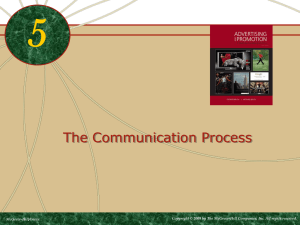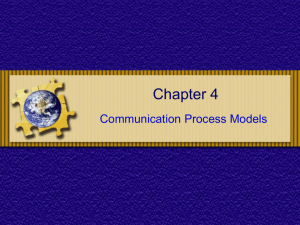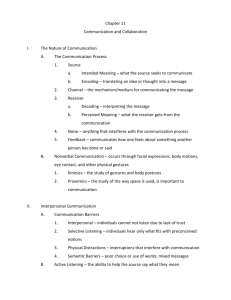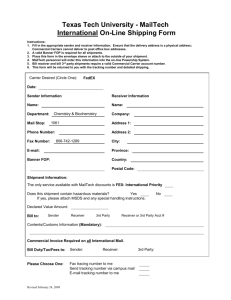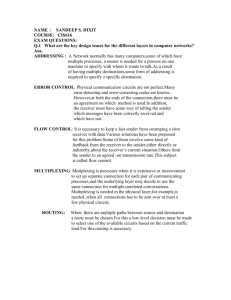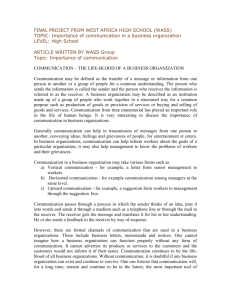The Communication Process
advertisement
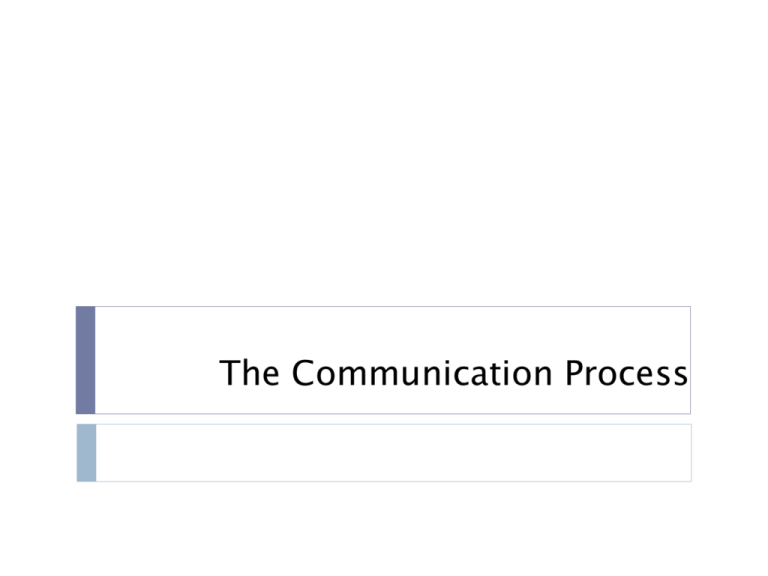
The Communication Process Learning Objectives To understand the basic elements of the communication process To analyze the response processes of receivers of marketing communications To examine the nature of consumers’ cognitive processing of marketing communications Communication ...the passing of information, the exchange of ideas, or the process of establishing a commonness or oneness of thought between a sender and a receiver. For communication to occur there must be: -common thinking between two parties -information must be passed from one person to another. A Basic Model of Communication Source/sender Encoding Channel message Decoding Receiver Source Encoding A source of communication is the person or organization that has information to share with another person or group of people. The source may be a salesperson, a celebrity, or a corporation or an organization Source encoding Source encoding Communication process begins when the source selects words, symbols, pictures to represent the message that will be delivered to receiver. This process known as encoding Encoding involves putting thoughts, ideas, or information into a symbolic form. Source encoding The sender’s goal is to encode the message in such a way that it will be understood by the receiver. Using words, signs, symbols that are familiar to the target audience. Message … message contains the information or meaning of the source hopes to convey/deliver. Message can be verbal or nonverbal, oral, written or symbolic. Message must be put into transmittable form that is appropriate for the channel of communication (example, words or images). Channel …is a method by which the communication travels from the source or the sender to the receiver. Two types of channels; -personal and nonpersonal Personal (face-to-face) Nonpersonal – no interpersonal contact between sender and receiver, also referred to as mass media. Receiver/decoding Receiver is the person with whom the sender shares thought or information. Decoding is the process of transforming the sender’s message back into thought. Noise Noise refers to unplanned distortion or interference. Response/feedback Refers to the reaction the receiver has after seeing, hearing, and reading the message. Responses range from storing information in memory and taking immediate action such as buying a product in a direct response to ad. Feedback provides the sender with a way of monitoring how the message is being decoded and received by the target audience. Analyzing the receiver To communicate effectively, marketers must understand who their target market is and how they need to be communicated with to influence their decision-making process. Identifying the target audience Consisting of: Individuals – target audience for some products are individuals, such as insurance and financial services. Must be specifically tailored. Group audiences- such as buying centers. Requires communication with multiple parties. Identifying target audience Market segments-customers who have similar needs and wants and thus represent market segments that can be reached via the same basic communication strategy. Market niches refers to a very small and well defined group can be reached via direct mail. Mass audience – communicating with large numbers of consumers via the mass media. The Response Process An important aspect of developing effective communication involves understanding the receiver response process. Four traditional response hierarchy models: the AIDA model, the hierarchy-of-effects-model, the innovation-adoption model and the information-processing model. The Traditional Response Hierarchy Models The AIDA Model Attention-Interest-Desire-Action The Hierarchy-of-effects Model Awareness-Knowledge-Liking-PreferenceConviction-Purchase The Traditional Response Hierarchy Models The Innovation-Adoption Model Awareness-Interest-Evaluation-Trial-Adoption The Information-Processing Model Presentation-Attention (listen)Comprehension(checklist)-Yielding (brand attitudes)-Retention (recall)-Behavior Traditional response hierarchy CAB Theory (Cognitive-Affective-Conative/behavior) Traditional response hierarchy The Standard Learning Hierarchy Learn-feel-do Products: high-involvement (e.g., notebook, camera) The Dissonance/Attribution Hierarchy Do-feel-learn Products: alternatives of similar quality and price The Low-Involvement Hierarchy Learn-do-feel Products: low-involvement products (e.g., soap, toothpaste) Model of Information Processing is developed by Michael Ray The Traditional Responses Hierarchy Model These models are useful as they delineate the series of stages potential purchasers go through to shift them from no awareness of products to readiness to purchase them. These models view the response process as consisting of movements from cognitive, affective and behavior. Cognitive Processing of Communications The inability of hierarchical response to explain what might be causing these reactions has led to an interest in understanding the nature of cognitive processing of advertising and other persuasive communications. Cognitive processing concerns how the external information (advertising message) is transformed into meanings or patterns of thoughts and how these meanings are combined to form judgments. Cognitive Processing of Communications Two models have been developed to examine the nature of consumers’ cognitive processing of advertising messages: The Cognitive Response Approach The Elaboration Likelihood Model Fight your worst fear. Use Baygon The Cognitive Response Approach The focus of this approach is to determine the types of thought evoked by an advertising message and how these responses relate to attitude toward the ad, brand attitudes and purchase intention. The three basic categories of cognitive responses are: product-message thoughts, source-oriented thoughts and ad execution thoughts. The Cognitive Response Approach The product/message thought – counterarguments and support arguments Source-oriented thought – source derogations (negative thoughts about the spokesperson or organization) and source bolster (react favorably). Ad execution thought – includes reactions to the ad execution factors such as the creativity of the ad, quality of visual effects, colors and voice tones. Can be either favorable or unfavorable. This may affects attitudes toward the ads as well as the brand. The Elaboration Likelihood Model Attitude formation and or change process depends on the amount and nature of elaboration, or processing, of relevant information the receiver engages in careful consideration, thinking, and evaluation of the information or arguments contained in the message. Viking: Nothing cuts grass better Elaboration Likelihood Model There are two basic processes or routes to persuasion, which are based on motivation and ability to process the message: The central route to persuasion The peripheral route to persuasion Breathe Right: Get rid of the Snore Elaboration Likelihood Model Central route to persuasion- the receiver is viewed as a very active and involved participant in the communication process whose ability and motivation to attend, comprehend and evaluate message are very high. Peripheral route to persuasion- the receive is viewed as lacking motivation or ability to process information and is not likely to engage in detailed cognitive processing.
